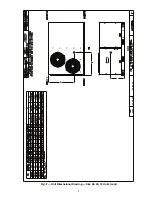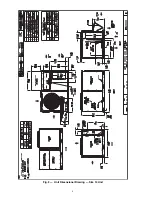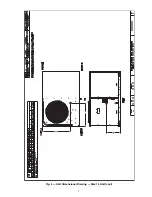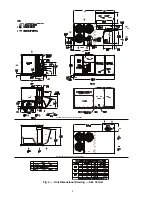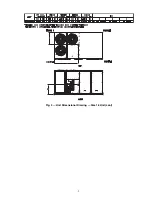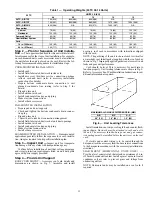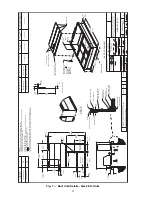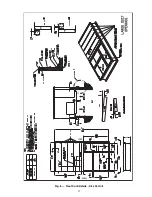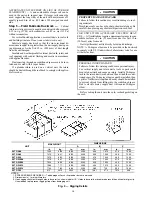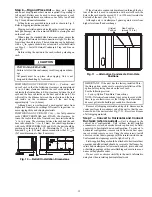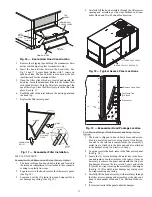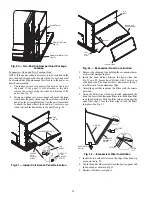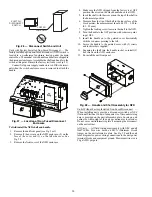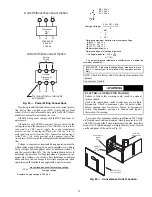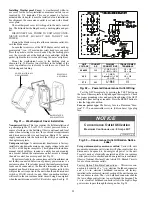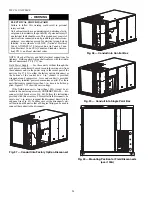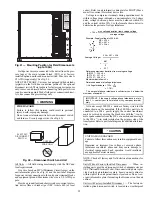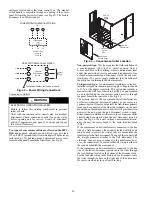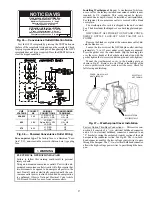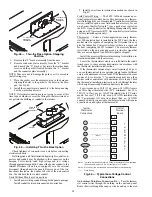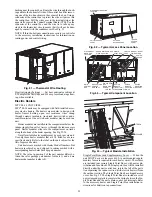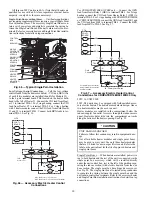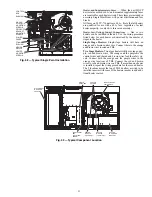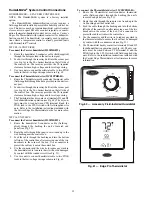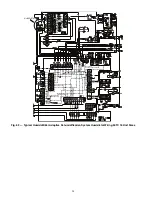
19
Step 9 — Install External Condensate Trap
and Line —
The unit has one
3
/
4
-in. condensate drain con-
nection on the end of the condensate pan and an alternate con-
nection on the bottom. See Fig. 24. Unit airflow configuration
does not determine which drain connection to use. Either drain
connection can be used with vertical or horizontal applications.
When using the 50TC*16 standard side drain connection,
ensure the red plug in the alternate bottom connection is tight.
Do this before setting the unit in place. The red drain pan can
be tightened with a
1
/
2
in. square socket drive extension.
To use the alternate bottom drain connection, remove the
red drain plug from the bottom connection (use a
1
/
2
-in. square
socket drive extension) and install it in the side drain connec-
tion.
Fig. 24 — Condensate Drain Pan (Side View)
The piping for the condensate drain and external trap can be
completed after the unit is in place. See Fig. 25.
Fig. 25 — Condensate Drain Piping Details
All units must have an external trap for condensate drain-
age. Install a trap at least 4-in. (102 mm) deep and protect
against freeze-up. If drain line is installed downstream from the
external trap, pitch the line away from the unit at 1-in. per 10 ft
(25 mm in 3 m) of run. Do not use a pipe size smaller than the
unit connection (
3
/
4
-in.).
Step 10 — Make Electrical Connections
50TC 08-14 UNIT SIZES
NOTE: Check all factory and field electrical connections for
tightness. Field-supplied wiring shall conform with the limita-
tions of minimum 63°F (33°C) rise.
Field Power Supply — If equipped with optional Powered
Convenience Outlet: The power source leads to the conve-
nience outlet’s transformer primary are not factory connected.
Installer must connect these leads according to required opera-
tion of the convenience outlet. If an always-energized conve-
nience outlet operation is desired, connect the source leads to
the line side of the unit-mounted disconnect. (Check with local
codes to ensure this method is acceptable in your area.) If a de-
energize via unit disconnect switch operation of the conve-
nience outlet is desired, connect the source leads to the load
side of the unit disconnect. On a unit without a unit-mounted
disconnect, connect the source leads to compressor contactor C
and indoor fan contactor IFC pressure lugs with unit field
power leads.
Refer to Fig. 32 for power transformer connections and the
discussion on connecting the convenience outlet.
Field power wires are connected to the unit at line-side pres-
sure lugs on compressor contactor C and indoor fan contactor
IFC (see wiring diagram label for control box component ar-
rangement) or at factory-installed option non-fused disconnect
switch. Max wire size is #4 AWG (copper only). (See Fig. 29.)
NOTE: TEST LEADS - Unit may be equipped with short leads
(pigtails) on the field line connection points on contactor C or
optional disconnect switch. These leads are for factory run-test
purposes only; remove and discard before connecting field
power wires to unit connection points. Make field power con-
nections directly to line connection pressure lugs only.
DRAIN
(FACTORY-IN
S
TALLED)
PLUG
CONDEN
S
ATE PAN (
S
IDE VIEW)
S
TANDARD
S
IDE DRAIN
ALTERNATE
BOTTOM DRAIN
NOTE: Trap should be deep enough to offset maximum unit static
difference. A 4 in. (102 mm) trap is recommended.
MINIMUM PITCH
1˝ (25 mm) PER
1
0´
(
3 m) OF LINE
BASE RAIL
OPEN
VENT
TO ROOF
DRAIN
DRAIN PLUG
ROOF
CURB
SEE NOTE
3˝(76 mm)
MIN
WARNING
ELECTRICAL SHOCK HAZARD
Failure to follow this warning could result in personal
injury or death.
Do not use gas piping as an electrical ground.
Unit cabinet
must have an uninterrupted, unbroken electrical ground to
minimize the possibility of personal injury if an electrical
fault should occur. This ground may consist of electrical
wire connected to unit ground lug in control compartment,
or conduit approved for electrical ground when installed in
accordance with NEC (National Electrical Code); ANSI/
NFPA 70, latest edition (in Canada, Canadian Electrical
Code CSA [Canadian Standards Association] C22.1), and
local electrical codes.
WARNING
FIRE HAZARD
Failure to follow this warning could result in personal
injury, death, or property damage.
Do not connect aluminum wire between disconnect switch
and furnace. Use only copper wire. (See Fig. 26.)
Summary of Contents for Carrier WeatherMaker 50TC A08 Series
Page 4: ...4 Fig 2 Unit Dimensional Drawing Size 08 09 12 Units...
Page 5: ...5 Fig 2 Unit Dimensional Drawing Size 08 09 12 Units cont...
Page 6: ...6 Fig 3 Unit Dimensional Drawing Size 14 Unit...
Page 7: ...7 Fig 3 Unit Dimensional Drawing Size 14 Unit cont...
Page 9: ...9 Fig 4 Unit Dimensional Drawing Size 16 Unit cont...
Page 13: ...13 Fig 8 Roof Curb Details Size 16 Unit...
Page 50: ...50 Fig 73 50TC 16 Control Box Component PremierLink Locations...
Page 51: ...51 Fig 74 Typical PremierLink Control Wiring Diagram...
Page 52: ...52 Fig 75 Typical PremierLink Control Wiring Diagram with Humidi MiZer System Option...
Page 64: ...64 Fig 106 Typical RTU Open Controller Wiring Diagram 50TC 08 14 Size Units...
Page 65: ...65 Fig 107 Typical RTU Open Controller Wiring Diagram 50TC 16 Size Unit...

